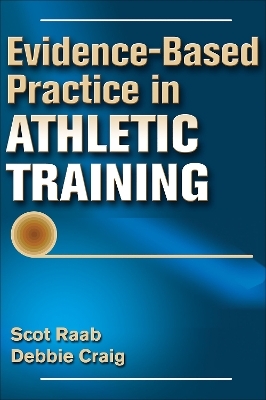
Evidence-Based Practice in Athletic Training
Human Kinetics (Verlag)
978-1-4504-9815-9 (ISBN)
Grounded in solid science, Evidence-Based Practice in Athletic Training explains the basics of EBP and the research design methods that are so vital to its implementation. Starting in part I, the text introduces the various levels of evidence, well-built question development using the PICO technique (patient problem or population, intervention, comparison, and outcomes), the five steps of searching for evidence, and search techniques. Part II guides readers through researching specific questions and evaluating research studies, including how to incorporate the evidence they find into their clinical practice. Part III reviews the various research types, their uses and benefits, and research ethics as a critical part of the process of EBP. Through these step-by-step chapters, readers will be able to formulate clinical questions, perform research on current studies, analyze the available data, and apply the principles in their practice in order to provide the best and most accurate care possible.
In addition to in-depth information on the principles and application of EBP, Evidence-Based Practice in Athletic Training presents clinically based scenarios that allow students to apply their recently acquired knowledge to real-life situations, thus encouraging a deeper understanding of the topics presented throughout the text. These scenarios allow those who are learning EBP concepts for the first time to understand how EBP is incorporated clinically.
The most efficient, systematic, and thorough resource of its kind, Evidence-Based Practice in Athletic Training encourages students and current certified athletic trainers to ask meaningful questions, gain the knowledge they need for excelling in future practice, and rise to the top of their profession. For students who want a thorough skill base in EBP and for credentialed health care professionals who seek further knowledge in the area, Evidence-Based Practice in Athletic Training will help all current and future athletic trainers provide the best care for their athletes and clients.
Scot Raab, PhD, is an assistant professor in the athletic training education program at Northern Arizona University in Flagstaff. Raab earned his PhD in teaching and administration and has more than 20 years of experience in clinical practice, higher education instruction, and methodological review to contribute to EBP education. He teaches several research courses and mentors undergraduate and graduate students in research projects. Debbie Craig, PhD, is the director of the athletic training education program in the department of physical therapy and athletic training and a professor at Northern Arizona University in Flagstaff. With more than a decade of clinical practice in athletic training and a PhD in educational leadership, Craig is an authority in EBP and research protocols. She teaches EBP to graduate students and is a member of the National Athletic Trainers’ Association.
Part I. Introduction
Chapter 1. Evidence-Based Practice Models
Definition of Evidence-Based Practice
Five Steps of Evidence-Based Practice
Levels of Evidence
Purpose of Evidence-Based Practice in Clinical Athletic Training
Summary
References
Chapter 2. Steps in Evidence-Based Practice Research
Step 1: Create a Clinically Relevant and Searchable Question Concerning Your Athlete
Step 2: Conduct a Database Search to Find the Best Evidence
Step 3: Critically Appraise the Articles or Evidence for Quality
Step 4: Critically Synthesize the Evidence to Choose and Implement a Treatment
Step 5: Assess the Outcomes by Monitoring the Athlete
Search Troubleshooting Tips
Summary
References
Chapter 3. Research Evaluation
Reliability
Validity
Prevalence Independent Test
Calculating Sensitivity and Specificity
Summary
References
Part II. Critical Appraisal of Evidence-Based Practice
Chapter 4. Diagnostic Research
Measurement
Methods
Summary
References
Chapter 5. Prognostic Research
Prognostic Designs
Prognostic Statistics
Appraisal Questions
Summary
References
Chapter 6. Systematic Reviews and Meta-Analyses
Review of the Evidence Pyramid
Definitions of and Differences Among Filtered Reviews
Strengths and Processes of Critically Appraised Topics
Strengths and Processes of Systematic Reviews
Strengths and Processes of Meta-Analyses
How to Find Critically Appraised Topics, Systematic Reviews, and Meta-Analyses
Practice EBP Searches
Summary
References
Chapter 7. EBP in Daily Clinical Practice
Your Practice Based on Evidence
Your Practice Based on Your Clinical Experience
Your Practice Based on Athlete Preferences and Values
Clinical Practice Guidelines
Practice Altruism
Summary
References
Chapter 8. Review Outcome Measures
Types of Outcome Measures
Psychometric Properties of Outcome Measures
Communicating Outcomes
Assessing Your Self-Practice
Adjusting Your Practice
Summary
References
Part III. Research Statistics and Design
Chapter 9. Quantitative Research
Types of Quantitative Data
Types of Quantitative Research Designs
Descriptive Statistics
Common Inferential Statistics
Summary
References
Chapter 10. Qualitative Studies
Types of Qualitative Research Studies
Gathering Data
Analyzing Data
Assessing Trustworthiness
Critical Appraisal of Qualitative Research Studies
Qualitative Research and Athletic Training
Summary
References
Chapter 11. Research Ethics
Ethical Roadblocks
Trustworthiness and Conflicts
Summary
References
| Verlagsort | Champaign, IL |
|---|---|
| Sprache | englisch |
| Maße | 178 x 254 mm |
| Gewicht | 590 g |
| Themenwelt | Sachbuch/Ratgeber ► Gesundheit / Leben / Psychologie |
| Sachbuch/Ratgeber ► Sport ► Fitness / Aerobic / Bodybuilding | |
| Medizin / Pharmazie ► Medizinische Fachgebiete ► Sportmedizin | |
| Medizin / Pharmazie ► Physiotherapie / Ergotherapie ► Rehabilitation | |
| ISBN-10 | 1-4504-9815-9 / 1450498159 |
| ISBN-13 | 978-1-4504-9815-9 / 9781450498159 |
| Zustand | Neuware |
| Informationen gemäß Produktsicherheitsverordnung (GPSR) | |
| Haben Sie eine Frage zum Produkt? |
aus dem Bereich


